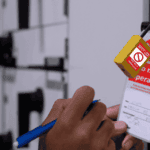
When a new employee joins a business, the first weeks or months function as a probationary period. During this time, both the employee and employer decide if the role is the right fit.
A probationary review happens at the end of this period. It’s a formal meeting where the employee’s performance is reviewed, feedback is given and a final hiring decision is made.
If you’re responsible for conducting probationary reviews, it’s important to do it properly. Rushed or unstructured reviews can lead to poor hiring decisions, unresolved performance issues or future legal disputes.
In this blog, we walk you through the process of conducting an effective probationary review step by step.
Key Takeaways
- Always prepare before the meeting by reviewing the employee’s work, feedback and goals.
- Make the employee feel at ease and let them share their views first.
- Give clear feedback using real examples, covering both strengths and areas to improve.
- Decide whether to pass, extend or end probation and explain the decision clearly.
- Stay calm, fair and consistent. Always prepare evidence to support your decision.
- Confirm the outcome in writing and keep a record for future reference.
What Is a Probationary Review?
A probationary review is a meeting between you and the employee held either during or at the end of their probation period. It provides an opportunity to discuss performance, offer feedback and agree on the next steps.
Mid-term probationary reviews are generally lower-stakes. They’re useful for raising concerns early and for providing feedback that supports the employee’s development.
End-of-probation reviews are more formal and should clearly confirm the final hiring decision. There are three possible outcomes:
- The employee passes probation and remains in the role
- The probation period is extended to allow time for improvement
- The employee does not pass and leaves the organisation
Because of the potential for disappointment or disagreement, it’s important to approach these meetings fairly, professionally and with evidence to support your decision.
Health and Safety Courses
Our health and safety courses support legal compliance and effective risk management. They raise awareness of common workplace hazards and teach the fundamentals of safe working.
Steps to Conduct an Effective Probationary Review
1. Understand the Purpose of a Probationary Review
A probationary review is an opportunity to verify that the employee is right for the position. You can discuss their work, their attitude and how well they fit into the team.
It’s also a time to give feedback and listen to how the employee feels about the role.
The review should be honest, clear and balanced. Always give the employee opportunities to respond, raise their concerns and ask questions.
2. Prepare for the Review
Before the meeting, revisit the employee’s job description, assess their performance against agreed objectives and review any relevant feedback from colleagues or managers.
Consider whether they’ve met expectations – both in terms of results and workplace behaviour. Have they achieved key goals? Shown the right skills and attitude? Struggled in any particular area? Collect clear, factual examples to support your assessment.
For end-of-probation reviews, the outcome should be decided in advance, based on the evidence you’ve gathered. However, you’re entitled to reconsider mid-meeting. Employees can sometimes share new information that should be taken into account.
Finally, always hold the review in a private space. A quiet, confidential setting helps the employee feel more comfortable and avoids unnecessary embarrassment if you need to deliver difficult news.
3. How to Start the Meeting
Begin by making the employee feel at ease. Thank them for their work during probation and explain clearly what the meeting is about: to discuss how things have gone and what happens next.
Ask them first how they think the probation has gone. Give them a chance to share their thoughts and listen carefully. Sometimes, they may reveal challenges you weren’t aware of.
4. Giving Your Feedback
After actively listening to the employee, it’s your opportunity to give feedback. Be clear, balanced and fair. Start by highlighting what they’ve done well, using specific examples so they understand exactly what you’re recognising.
Then address any concerns. Again, be specific and focus on observable behaviours. Instead of saying, “You need to be more proactive,” you might say, “There have been several instances where clients had to chase you for updates. Proactively sharing progress could improve both communication and trust.”
If improvement is needed, explain what that looks like in practical terms. Offer support where appropriate. This might include setting clearer targets, scheduling regular check-ins or arranging further training to build confidence or skills.
5. Sharing and Documenting the Hiring Decision
Remember, the final probationary review meeting is the time to communicate and confirm your hiring decision, not to make it in the moment. Your outcome should be clear, evidence-based and delivered professionally.
When communicating the decision:
- Be direct and respectful. Clearly state the outcome: whether the employee is passing, having their probation extended or leaving the organisation.
- Support your decision with specific examples from the probation period. Refer back to goals, feedback and earlier discussions.
- Give the employee time to process the outcome, especially if the decision is unexpected or disappointing.
What to document and why:
- Record the decision in writing, along with the key points discussed in the meeting.
- If probation is extended, clearly outline the timeframe, performance concerns and the specific targets the employee is expected to meet.
- If employment is ending, your records should show that the employee was given clear expectations, reasonable support, and fair warning.
Good documentation not only provides clarity for the employee, it protects your organisation if the decision is ever challenged.

6. Follow Up After the Meeting
After the meeting, you must confirm everything in writing.
If the employee passes, send them a letter or email confirming they are now a permanent employee.
If you extend their probation, confirm the length of the extension, what they need to improve and when you will review them again.
If you’re ending their employment, clearly explain the reasons for your decision. Ensure you provide the correct notice period or pay in lieu of notice, and follow your company’s dismissal procedure in line with employment law and the terms of their contract.
Keeping a written record helps prevent disputes or claims about how the probationary decision was handled.
Questions to Ask During a Probationary Review
During the review, it’s important to ask simple, open-ended questions that encourage detailed and honest responses from the employee. This approach shows that you are genuinely interested in their opinions, gives them a fair opportunity to reflect and may reveal insights that influence your final decision.
Here are some useful questions to consider:
- How do you feel the probation has gone?
- What have you enjoyed most about the role?
- What challenges have you faced?
- Do you feel you received enough support and training?
- What goals would you like to work towards?
- Is there anything we could do to help you succeed?
The answers may highlight concerns or successes you were unaware of, helping you make a better-informed decision. You might also receive valuable feedback to improve your onboarding and probation management processes in future.
Common Problems and How to Handle Them
Even with the best intentions, probationary reviews can go off track. Below are four common issues and advice on how to handle them.
Lack of Clarity
If expectations weren’t clearly communicated at the start of the probation, it becomes difficult (and unfair) to judge whether the employee has met them.
How to handle it:
- Focus on any written objectives, job descriptions or training records
- Acknowledge any ambiguity and be honest about it.
- If expectations were unclear, consider whether an extension with well-defined goals is a fairer approach than ending the contract outright.
Going forward, ensure all new hires receive written targets, role expectations and regular feedback from day one.
Lack of Objectivity
It’s easy for unconscious bias, frustration or isolated incidents to skew your judgement, especially if feedback and performance haven’t been documented during the probationary period.
How to handle it:
- Stick to facts, not impressions. Use specific examples tied to agreed goals or behaviours.
- Review all feedback – positive and negative – to ensure your decision reflects the full picture.
- Be aware of your tone and language. Avoid subjective phrasing. For example, don’t say, “You’ve been really unreliable.” Instead, make your language impersonal and objective. A better version would be, “You missed three agreed deadlines without making your manager aware of an issue.”
One-Sided Conversations
If the meeting becomes a lecture, you may miss key information that could influence your decision or undermine the employee’s trust in the process.
How to handle it:
- Allow space for the employee to speak. Ask open questions and give them time to respond.
- Acknowledge their perspective, even if it doesn’t change your final outcome.
- Keep the tone constructive. The review should feel like a conversation, not a verdict.
4. Surprising the Employee with a Negative Outcome
Delivering negative feedback or ending employment unexpectedly is poor practice and more likely to cause upset, conflict or even legal risk.
How to handle it:
- Raise concerns early in the probation period. Use regular check-ins to flag issues and offer support.
- If no prior feedback has been given, consider whether an extension is more appropriate than dismissal.
- If ending the contract is unavoidable, be respectful and clear, and ensure you can justify the decision with written evidence.
Strengthen Your Probationary Review Skills
Well-managed probation reviews help build strong teams and avoid costly mistakes. Good preparation, clear feedback and fair decisions help protect your business and bring in talent.
If you want to build your skills further, our Probationary Period Management Training can help. This online course provides practical guidance on managing probation periods, handling reviews fairly and making informed, evidence-based decisions. It covers legal responsibilities, best practice tips and common mistakes to avoid.
Enrol in the training programme and get the skills you need to run effective probationary reviews with confidence.





















